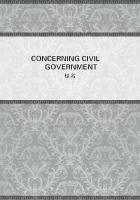Scarcely more than half a century has passed since the Dominion of Canada, in its present form, came into existence.But thrice that period has elapsed since the fateful day when Montcalm and Wolfe laid down their lives in battle on the Plains of Abraham, and the lands which now comprise the Dominion finally passed from French hands and came under British rule.
The Peace of Paris, which brought the Seven Years' War to a close in 1763, marked the termination of the empire of France in the New World.Over the continent of North America, after that peacee, only two flags floated, the red and yellow banner of Spain and the Union Jack of Great Britain.Of these the Union Jack held sway over by far the larger domain--over the vague territories about Hudson Bay, over the great valley of the St.
Lawrence, and over all the lands lying east of the Mississippi, save only New Orleans.To whom it would fall to develop this vast claim, what mighty empires would be carved out of the wilderness, where the boundary lines would run between the nations yet to be, were secrets the future held.Yet in retrospect it is now clear that in solving these questions the Peace of Paris played no inconsiderable part.By removing from the American colonies the menace of French aggression from the north it relieved them of a sense of dependence on the mother country and so made possible the birth of a new nation in the United States.At the same time, in the northern half of the continent, it made possible that other experiment in democracy, in the union of diverse races, in international neighborliness, and in the reconciliation of empire with liberty, which Canada presents to the whole world, and especially to her elder sister in *******.
In 1763 the territories which later were to make up the Dominion of Canada were divided roughly into three parts.These parts had little or nothing in common.They shared together neither traditions of suffering or glory nor ties of blood or trade.
Acadia, or Nova Scotia, by the Atlantic, was an old French colony, now British for over a generation.Canada, or Quebec, on the St.Lawrence and the Great Lakes, with seventy thousand French habitants and a few hundred English camp followers, had just passed under the British flag.West and north lay the vaguely outlined domains of the Hudson's Bay Company, where the red man and the buffalo still reigned supreme and almost unchallenged.
The old colony of Acadia, save only the island outliers, Cape Breton and Prince Edward Island, now ceded by the Peace of Paris, had been in British hands since 1713.It was not, however, until 1749 that any concerted effort had been made at a settlement of this region.The menace from the mighty fortress which the French were rebuilding at that time at Louisbourg, in Cape Breton, and the hostility of the restless Acadians or old French settlers on the mainland, had compelled action and the British Government departed from its usual policy of laissez faire in matters of emigration.Twenty-five hundred English settlers were brought out to found and hold the town and fort of Halifax.Nearly as many Germans were planted in Lunenburg, where their descendants flourish to this day.Then the hapless Acadians were driven into exile and into the room they left, New Englanders of strictest Puritan ancestry came, on their own initiative, and built up new communities like those of Massachusetts, Connecticut, and Rhode Island.Other waves of voluntary immigration followed--Ulster Presbyterians, driven out by the attempt of England to crush the Irish woolen manufacture, and, still later, Highlanders, Roman Catholic and Presbyterian, who soon made Gaelic the prevailing tongue of the easternmost counties.By 1767 the colony of Nova Scotia, which then included all Acadia, north and east of Maine, had a prosperous population of some seven thousand Americans, two thousand Irish, two thousand Germans, barely a thousand English, and well over a thousand surviving Acadian French.In short, this northernmost of the Atlantic colonies appeared to be fast on the way to become a part of New England.It was chiefly New Englanders who had peopled it, and it was with New England that for many a year its whole social and commercial intercourse was carried on.It was no accident that Nova Scotia later produced the first Yankee humorist, "Sam Slick."With the future sister province of Canada, or Quebec, which lay along the St.Lawrence as far as the Great Lakes, Acadia or Nova Scotia had much less in common than with New England.Hundreds of miles of unbroken forest wilderness lay between the two colonies, and the sea lanes ran between the St.Lawrence, the Bay of Fundy, or Halifax and Havre or Plymouth, and not between Quebec and Halifax.Even the French settlers came of different stocks.The Acadians were chiefly men of La Rochelle and the Loire, while the Canadians came, for the most part, from the coast provinces stretching from Normandy and Picardy to Poitou and Bordeaux.















